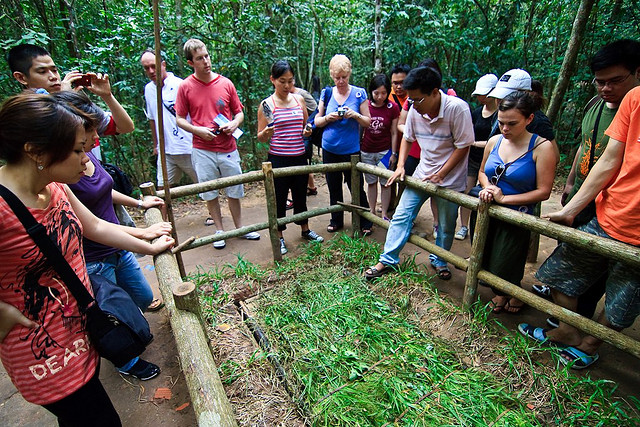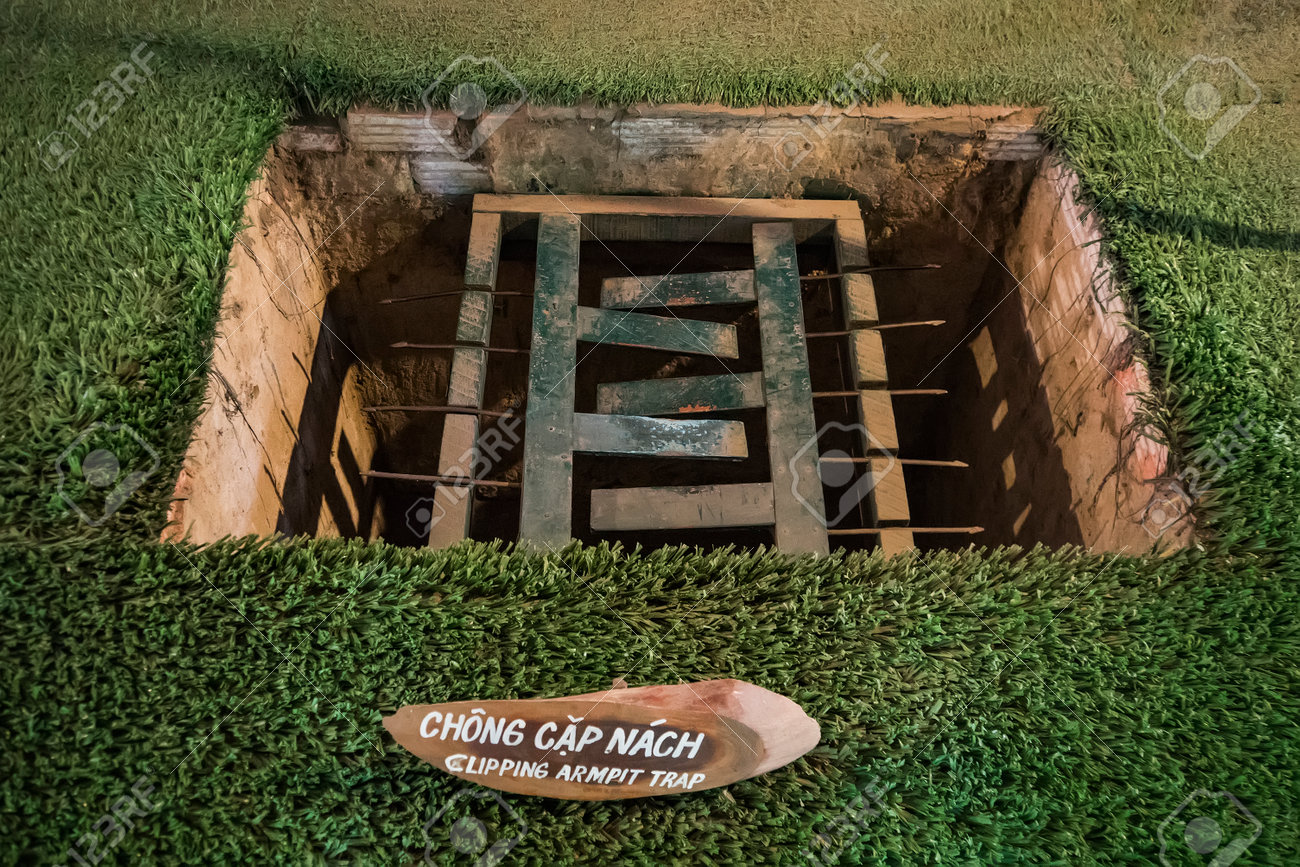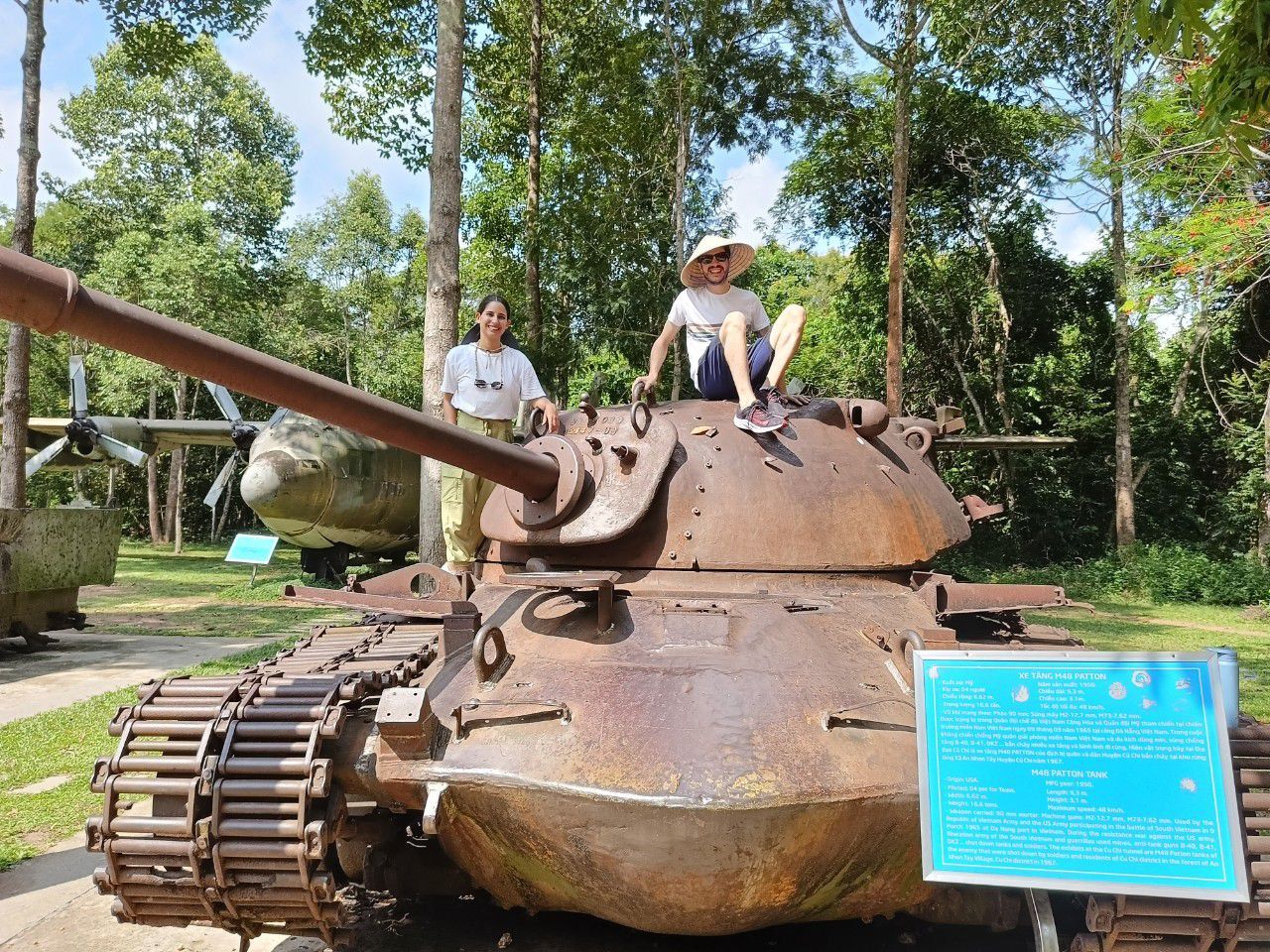Table of Contents
The tunnels of Cu Chi Vietnam war a tumultuous and devastating conflict that lasted for over two decades, from 1955 to 1975. It saw the involvement of major world powers, with the United States supporting the South Vietnamese government against the communist North Vietnamese forces. One of the most intriguing aspects of this war was the use of underground tunnels by the Viet Cong, a guerrilla force fighting against the American and South Vietnamese troops. These tunnels, located in the district of Cu Chi just northwest of Saigon (now Ho Chi Minh City), played a crucial role in the war and are still a significant part of Vietnam’s history today.
History of the tunnels of Cu Chi Vietnam war

The construction of the Cu Chi tunnels began in the early 1940s during the French colonial era when they were used by the Viet Minh, a nationalist movement fighting for independence from France. The tunnels were initially small and simple, used mainly for hiding and storing supplies. However, after the Geneva Accords of 1954, which partitioned Vietnam into two separate states, the tunnels were further expanded and developed by the Viet Cong, a communist-led insurgency that aimed to unify the country under communist rule.
The Viet Cong saw the potential of the tunnels as a strategic asset in their fight against the American and South Vietnamese forces. They dug deeper and wider tunnels, connecting them to form a vast network that stretched over 250 kilometers. These tunnels served as a hidden base of operations, a communication network, and a means of transportation for the Viet Cong.
Timeline of Events:
| Year | Event |
|---|---|
| 1940s | Construction of small tunnels by the Viet Minh |
| 1954 | Expansion and development of tunnels by the Viet Cong |
| 1960s | Tunnels extended to over 250 kilometers |
| 1965 | American forces discover the tunnels |
| 1966 | Operation Crimp launched to destroy the tunnels |
| 1968 | Tet Offensive sees the use of tunnels by the Viet Cong |
| 1973 | Ceasefire agreement signed, but fighting continues in the tunnels |
| 1975 | Fall of Saigon and end of the Vietnam War |
Strategic Importance of the Tunnels of Cu Chi

The tunnels of Cu Chi Vietnam war were strategically located in a dense jungle area, providing natural camouflage and making them difficult for the American and South Vietnamese forces to detect. The tunnels were also situated near important transportation routes and military installations, allowing the Viet Cong to launch surprise attacks on enemy positions.
The tunnels served as a secure base of operations for the Viet Cong, where they could store supplies, house troops, and plan attacks. They also had hospitals, kitchens, and even schools within the tunnels, making them self-sufficient and able to sustain long-term operations. The tunnels also provided shelter from the intense bombing campaigns carried out by the American forces.
Advantages of the Tunnels for the Viet Cong:
- Natural camouflage
- Proximity to important targets
- Secure base of operations
- Self-sufficiency
- Protection from bombings
Construction and Design of the Tunnels of Cu Chi

The construction of the tunnels was a remarkable feat, considering the limited resources and primitive tools available to the Viet Cong. The tunnels were dug by hand using simple tools such as shovels, hoes, and pickaxes. Bamboo and wood were used to reinforce the walls and ceilings, and air vents were strategically placed to provide ventilation and prevent detection.
The tunnels were designed with multiple levels, ranging from 3 to 10 meters deep, to protect against aerial bombings. The narrow passageways were also designed to prevent larger soldiers from entering, giving the smaller and more agile Viet Cong an advantage. Booby traps were also set up throughout the tunnels to defend against enemy attacks.
Design Features of the Tunnels:
- Multiple levels for protection against bombings
- Narrow passageways to prevent larger soldiers from entering
- Air vents for ventilation
- Booby traps for defense
Life in the Tunnels of Cu Chi during the Vietnam War

The tunnels of Cu Chi Vietnam war were not only used for military purposes but also served as a home for many Viet Cong soldiers and their families. Living conditions in the tunnels were harsh, with limited space, poor ventilation, and constant fear of being discovered by the enemy. The soldiers had to adapt to living in complete darkness for extended periods, which took a toll on their physical and mental health.
Despite the difficult living conditions, the Viet Cong soldiers showed remarkable resilience and resourcefulness. They built kitchens, hospitals, and even schools within the tunnels, and some soldiers even managed to grow crops underground. The tunnels also had a sophisticated communication system, allowing the Viet Cong to coordinate their movements and launch surprise attacks on the enemy.
Daily Life in the Tunnels:
- Limited space and poor ventilation
- Adaptation to living in complete darkness
- Resourcefulness in building kitchens, hospitals, and schools
- Sophisticated communication system
Tactics and Operations of the Viet Cong in the Tunnels of Cu Chi

The Viet Cong utilized various tactics and operations in the tunnels to gain an advantage over the American and South Vietnamese forces. One of their most effective tactics was the use of booby traps, which caused significant casualties among the enemy troops. These traps were often made from everyday items such as bamboo spikes, tripwires, and grenades, making them difficult to detect.
The tunnels also allowed the Viet Cong to launch surprise attacks on the enemy, disappearing into the tunnels after the attack and reappearing in a different location. This tactic, known as “hit and run,” was highly effective in wearing down the enemy’s morale and resources.
Tactics and Operations used by the Viet Cong:
- Use of booby traps
- Surprise attacks and “hit and run” tactics
- Disappearing into the tunnels after an attack
Impact of the Tunnels of Cu Chi on the Outcome of the Vietnam War
The tunnels of Cu Chi played a significant role in the outcome of the Vietnam War. They allowed the Viet Cong to launch surprise attacks and sustain long-term operations, which proved to be a major challenge for the American and South Vietnamese forces. The tunnels also served as a symbol of the resilience and determination of the Viet Cong, who were able to withstand intense bombing campaigns and continue fighting.
The American forces attempted to destroy the tunnels through Operation Crimp in 1966, but it was largely unsuccessful. The Tet Offensive in 1968, where the Viet Cong launched a series of coordinated attacks across South Vietnam, also saw the use of the tunnels. Despite the eventual withdrawal of American troops in 1973, the fighting continued in the tunnels until the fall of Saigon in 1975.
Statistics:
| Year | Number of American Troops in Vietnam |
|---|---|
| 1965 | 184,300 |
| 1966 | 385,300 |
| 1967 | 485,600 |
| 1968 | 536,100 |
| 1969 | 543,400 |
| 1970 | 334,600 |
| 1971 | 156,800 |
| 1972 | 24,200 |
| 1973 | 50 |
(Source: National Archives)
Tourism and Preservation of the Tunnels of Cu Chi
After the end of the Vietnam War, the tunnels of Cu Chi were abandoned and left to decay. However, in the 1980s, the Vietnamese government recognized their historical significance and began efforts to preserve and promote them as a tourist attraction.
Today, the Cu Chi tunnels are a popular tourist destination, with visitors able to explore a small section of the tunnels and learn about their history through guided tours. The tunnels have been expanded and reinforced to accommodate tourists, but they still provide a glimpse into the harsh conditions that the Viet Cong soldiers endured during the war.
Tourism Statistics:
| Year | Number of Tourists Visiting Vietnam |
|---|---|
| 1995 | 1.8 million |
| 2000 | 2.1 million |
| 2005 | 3.4 million |
| 2010 | 5 million |
| 2015 | 7.9 million |
| 2020 | 18 million |
(Source: World Bank)
Comparison of the Tunnels of Cu Chi to Other Underground Systems
The tunnels of Cu Chi are not the only underground systems used in warfare. Throughout history, various civilizations have utilized underground tunnels and passageways for military purposes. One notable example is the elaborate network of tunnels built by the Romans to transport troops and supplies during battles.
Another well-known underground system is the tunnel complex used by the North Vietnamese forces during the Vietnam War. Located in the mountains near the border with Laos, these tunnels served as a supply route for the North Vietnamese troops fighting in South Vietnam.
Comparison Table:
| Tunnel System | Location | Purpose | Length |
|---|---|---|---|
| Cu Chi Tunnels | Vietnam | Military operations | 250 km |
| Roman Tunnels | Europe | Transporting troops and supplies | Unknown |
| North Vietnamese Tunnels | Vietnam/Laos border | Supply route for troops | Unknown |
Controversies Surrounding the Tunnels of Cu Chi
The tunnels of Cu Chi have been a subject of controversy, with some questioning their historical accuracy and others criticizing their use as a tourist attraction. Some argue that the tunnels have been exaggerated for propaganda purposes, while others believe that they should not be commercialized and instead preserved solely for educational purposes.
There have also been concerns about the safety of tourists exploring the tunnels, as well as the impact of increased tourism on the surrounding environment. However, the Vietnamese government has taken steps to address these issues by implementing safety measures and promoting sustainable tourism practices.
Controversial Issues:
- Historical accuracy
- Commercialization and tourism impact
- Safety concerns for tourists
- Environmental impact
Legacy of the Tunnels of Cu Chi in Modern-Day Vietnam
The tunnels of Cu Chi remain a significant part of Vietnam’s history and have become a symbol of the country’s resilience and determination during the Vietnam War. They serve as a reminder of the sacrifices made by the Viet Cong soldiers and the devastating effects of war on a nation.
Today, the tunnels are also used as a site for education and research, with many schools and universities organizing field trips to learn about the war and its impact on Vietnam. The tunnels have also been recognized as a UNESCO World Heritage Site, further cementing their importance in Vietnam’s history and culture.
Conclusion
The tunnels of Cu Chi Vietnam war are a testament to the ingenuity and determination of the Viet Cong during the Vietnam War. They played a crucial role in the outcome of the war and continue to be a significant part of Vietnam’s history today. Despite the controversies surrounding them, the tunnels serve as a reminder of the human cost of war and the resilience of the Vietnamese people. As we explore these tunnels, we gain a deeper understanding of the past and the impact it has on the present.